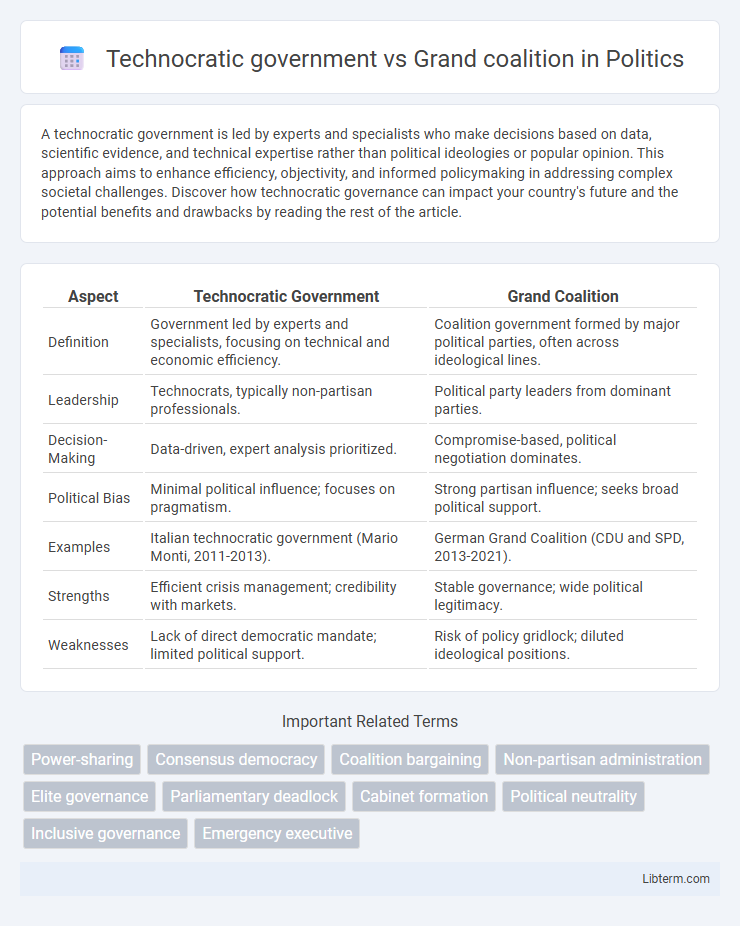A technocratic government is led by experts and specialists who make decisions based on data, scientific evidence, and technical expertise rather than political ideologies or popular opinion. This approach aims to enhance efficiency, objectivity, and informed policymaking in addressing complex societal challenges. Discover how technocratic governance can impact your country's future and the potential benefits and drawbacks by reading the rest of the article.
Table of Comparison
| Aspect | Technocratic Government | Grand Coalition |
|---|---|---|
| Definition | Government led by experts and specialists, focusing on technical and economic efficiency. | Coalition government formed by major political parties, often across ideological lines. |
| Leadership | Technocrats, typically non-partisan professionals. | Political party leaders from dominant parties. |
| Decision-Making | Data-driven, expert analysis prioritized. | Compromise-based, political negotiation dominates. |
| Political Bias | Minimal political influence; focuses on pragmatism. | Strong partisan influence; seeks broad political support. |
| Examples | Italian technocratic government (Mario Monti, 2011-2013). | German Grand Coalition (CDU and SPD, 2013-2021). |
| Strengths | Efficient crisis management; credibility with markets. | Stable governance; wide political legitimacy. |
| Weaknesses | Lack of direct democratic mandate; limited political support. | Risk of policy gridlock; diluted ideological positions. |
Defining Technocratic Government
A technocratic government consists of expert officials appointed based on their technical knowledge and specialized skills rather than political affiliations, aiming to implement efficient and pragmatic policies. Unlike a grand coalition, which merges multiple political parties to form a broad-based government, technocratic administrations prioritize expertise and non-partisan decision-making during times of crisis or transition. This approach emphasizes evidence-based governance to address complex economic or social challenges with minimal political influence.
Understanding Grand Coalition
Grand coalitions form when major political parties unite to create a broad-based government, typically during times of crisis or political stalemate, enhancing stability and collective decision-making. Unlike technocratic governments led by experts without strong party affiliations, grand coalitions blend diverse party ideologies to achieve consensus and implement agreed-upon policies. This approach emphasizes political compromise and shared governance, often leading to more inclusive and durable policy outcomes.
Historical Context of Technocratic Governments
Technocratic governments emerged prominently in the 20th century, often during periods of crisis or transition when traditional political parties failed to form stable coalitions, such as Italy's appointment of Mario Monti in 2011 amid the Eurozone debt crisis. Unlike grand coalitions, which unite major political parties to govern collectively, technocratic governments rely on experts and non-partisan specialists to implement policy based on technical expertise rather than political ideology. This historical approach aims to restore confidence and economic stability by prioritizing pragmatic decision-making over electoral considerations.
Grand Coalitions: Origins and Evolution
Grand coalitions trace their origins to periods of national crisis, where major political parties unite to ensure stability and governance continuity. Historically prominent in post-war Germany, grand coalitions have evolved to address political fragmentation by fostering cooperation between rival parties, often encompassing center-left and center-right factions. This form of government balances policy compromise with broad representation, maintaining functionality during times of polarization and institutional challenges.
Key Differences: Structure and Composition
A technocratic government is typically composed of experts and specialists selected based on technical knowledge and expertise rather than political affiliation, aiming for efficient, policy-driven decision-making focused on specific issues. In contrast, a grand coalition consists of representatives from multiple major political parties, combining varied political ideologies to form a broad-based government that emphasizes consensus and political stability. The technocratic model prioritizes professional competence and non-partisan governance, while the grand coalition relies on political negotiation and power-sharing among elected party leaders.
Decision-Making Processes Compared
Technocratic governments rely on expert-driven, evidence-based decision-making processes where appointed specialists prioritize technical solutions over political considerations. In contrast, grand coalitions involve power-sharing among multiple political parties requiring consensus-building and negotiation to reach policy agreements, often leading to slower decision-making. Technocratic models typically enable more streamlined responses to crises, whereas grand coalitions emphasize representational legitimacy and compromise.
Advantages of Technocratic Governance
Technocratic governance offers enhanced policy efficiency by relying on experts with specialized knowledge, leading to data-driven decisions and reduced political bias. This form of government improves accountability through merit-based appointments, ensuring officials are selected for competence rather than party allegiance. It also enables swift crisis management by circumventing prolonged political negotiations common in grand coalitions.
Strengths of Grand Coalitions
Grand coalitions combine the political strengths and diverse policy perspectives of major parties to enhance national stability and promote inclusive governance. They facilitate broad consensus on critical issues, enabling comprehensive reforms that reflect wide public support. This cooperative approach can effectively manage crises by balancing interests and minimizing partisan conflicts.
Challenges and Criticisms of Each Model
Technocratic governments face challenges such as limited democratic legitimacy and potential disconnect from public opinion, raising concerns about accountability and representativeness. Grand coalitions often struggle with policy gridlock and diluted party identities, which can weaken decisive governance and frustrate voters expecting clear ideological stances. Both models encounter criticism for inefficiency in addressing urgent socio-economic issues due to inherent structural compromises and competing interests.
Technocratic Government vs Grand Coalition: Future Prospects
Technocratic governments consist of experts appointed to manage crises without political affiliations, contrasting with grand coalitions that unite major parties to govern collaboratively. Future prospects for technocratic governments hinge on their ability to deliver efficient, non-partisan solutions during political deadlocks, while grand coalitions depend on balancing diverse party interests to maintain stability. Increasing public demand for effective governance amid complex challenges may enhance the appeal of technocratic administrations over traditional grand coalitions.
Technocratic government Infographic

 libterm.com
libterm.com